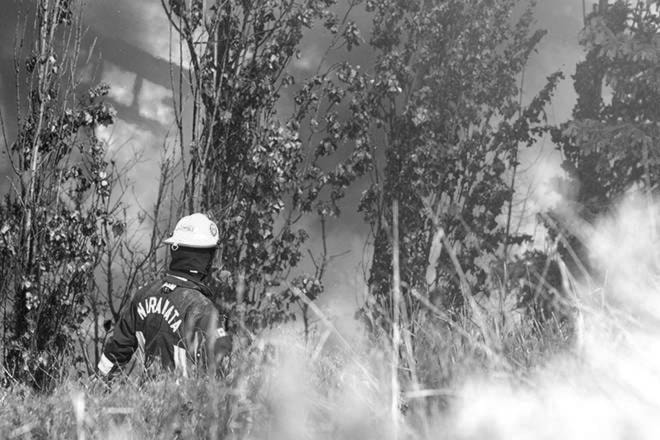Due to the massive increase in wildfire activity during 2017, homeowners are being urged to take advantage of the free FireSmart fire protection assessment being offered in the area. The Nakusp and Area Community Forest [NACFOR] and the Regional District of Central Kootenay [RDCK] are working with non-profit association FireSmart Canada to mitigate property loss in vulnerable rural areas. The assessment specialists will provide customized tips and strategies to reduce the risk of wildfire damage to homes and outbuildings during the 2018 fire season.
In rural areas where private property, crown land and forestry operations border each other, fire has become a monstrous threat that shows no signs of lessening. Public information sessions were recently held throughout the area. NACFOR and the RDCK are aiming to reach as many homeowners as possible. Their message: fire protection and preparedness.
Mark Elder who is a Forestry Tech with Cathro Consulting Ltd. and represented RDCK said, “In the last 10 years, 40,000 hectares were burned in total and in one year [2017] 9000 hectares burned. That’s almost two and a half times the average.”
2017 was an unprecedented year for wildfires in B.C. The mean average increase in wildfire activity amounted to 2250%, costing the province $400 million. Because 74% of this region’s fires are attributed to lighting strike and not to human activity, it can be assumed that the majority of damage was limited to back country terrain well away from dwellings. The Southeast Fire Center did not report the loss of any structures despite the dramatic increase last year. Wildfire Management issued a total of only four evacuation notices in Central Kootenay during the entire season, executing only one of those.
The RDCK wants to keep it that way. Dry conditions and climate change increase the threat and in reponse the region has bolstered efforts to protect its residents from unnecessary damage and loss. The Emergency Operations Centre [EOC] has grown in the last two years from a staff of three to include three managers, a structural protection officer and 9 wildfire mitigation specialists, who are performing the regional fire protection assessments.
For those who live in rural communities , calling 9-1-1 won’t automatically bring a wailing firetruck speeding to the door. Small town and volunteer fire departments may have their own contact numbers and can take time to arrive. Neighbourhood hydrants such as those in urban areas aren’t available in many rural communities. One of the best ways to protect property is by being diligent in fire prevention. It is critical to prepare to prevent the spread of wildfire on private property where pets, livestock, structures and people can be at risk. Carefully planning landscaping to include less flammable vegetation and using fire retardent building materials such as metal roofing can protect a home at risk.
Elder explained “Structures are often destroyed by ember storm and not by being in the path of the fire. It’s rare that the flames [of a wildfire] directly burn a house. It’s more common that the flames produce an ember shower that travels up to three kilometers, generating its own wind from the heat.” The wind then blows embers into trees, woodpiles, vegetation, railings and decking around a home, igniting disaster. The placement and maintenance of flammable outdoor hazards and installation of sprinkler systems can mean the difference between a dwelling being lost or spared in the event of an encroaching blaze.
Elder stressed that preparedness is key. He strongly recommends having a 72-hour evacuation preparedness kit and a plan for your family, your pets and livestock. The FireSmart property assessment is free and available to everyone. To book an assessment, contact Nora Hannon at nhannon@rdck.bc.ca or by calling 250-352-8177.
